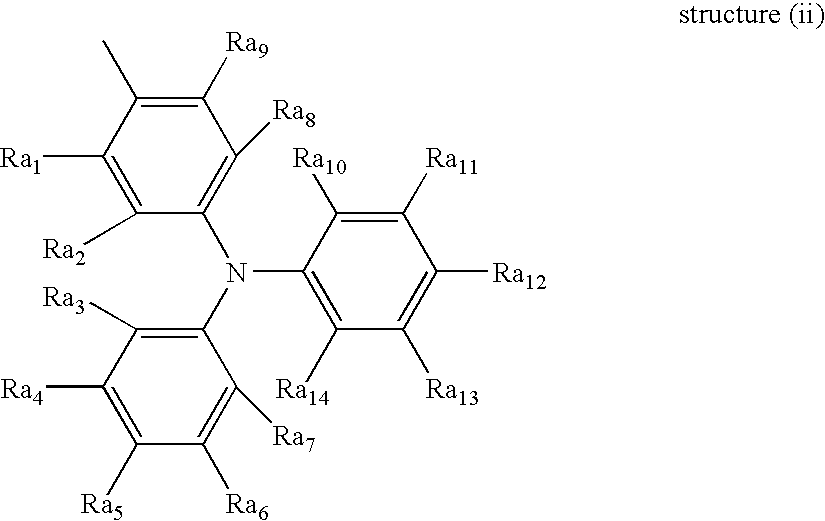Photorefractive composition
- Summary
- Abstract
- Description
- Claims
- Application Information
AI Technical Summary
Benefits of technology
Problems solved by technology
Method used
Image
Examples
production example 1
(a) Precursors Containing Charge Transport Groups
The following types of charge transport monomers were synthesized as follows.
(i) Tetradiphenyldiamine-type monomer:
(ii) Tri diphenyldiamine-type monomer:
iii) Tri diphenyldiamine-type monomer:
In the above procedure, usage of 3-methyl diphenylamine instead of diphenylamine and 3-methylphenyl halide instead of phenyl halide can result in the formation of N(acroyloxypropylphenyl)-N′-phenyl-N,N′-di(3-methylphenyl)-(1,1′-biphenyl)-4,4′-diamine.
b) Synthesis of Non-Linear-Optical Chromophore 7-DCST
The non-linear-optical precursor 7-DCST (7 member ring dicyanostyrene, 4-homopiperidinobenzylidene malononitrile) was synthesized according to the following two-step synthesis scheme:
A mixture of 4-fluorobenzaldehyde (17.8 g, 143 mmol), homopiperidine (15.0 g, 151 mmol), lithium carbonate (55 g, 744 mmol), and DMF (100 mL) was stirred at 50° C. for 16 hr. Water (500 mL) was added to the reaction mixture. The products were extrac...
production example 2
(Synthesis of tetradiphenyldiamine-type polysiloxane)
Tetradiphenyldiamine-type polysiloxane was prepared by the following procedure
The weight average and number average molecular weights were measured by gel permeation chromatography, using a polystyrene standard. The results were Mn=14,000, Mw=20,000, giving a polydispersity of 1.43. Tg (glass transition temperature) was 85° C.
production example 3
(Synthesis of tri diphenyldiamine-type polysiloxane)
Tri diphenyldiamine-type polysiloxane was prepared by the following procedure.
The weight average and number average molecular weights were measured by gel permeation chromatography, using a polystyrene standard. The results were Mn=8,800, Mw=14,600, giving a polydispersity of 1.66. Tg (glass transition temperature) was 72° C.
PUM
| Property | Measurement | Unit |
|---|---|---|
| Temperature | aaaaa | aaaaa |
| Fraction | aaaaa | aaaaa |
| Fraction | aaaaa | aaaaa |
Abstract
Description
Claims
Application Information
 Login to View More
Login to View More - Generate Ideas
- Intellectual Property
- Life Sciences
- Materials
- Tech Scout
- Unparalleled Data Quality
- Higher Quality Content
- 60% Fewer Hallucinations
Browse by: Latest US Patents, China's latest patents, Technical Efficacy Thesaurus, Application Domain, Technology Topic, Popular Technical Reports.
© 2025 PatSnap. All rights reserved.Legal|Privacy policy|Modern Slavery Act Transparency Statement|Sitemap|About US| Contact US: help@patsnap.com



